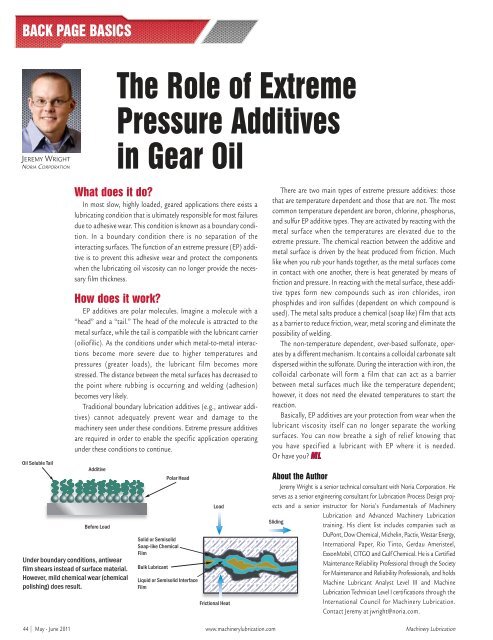Machinery Lubrication May June 2011 - Welcome to ECN Digital ...
Machinery Lubrication May June 2011 - Welcome to ECN Digital ...
Machinery Lubrication May June 2011 - Welcome to ECN Digital ...
Create successful ePaper yourself
Turn your PDF publications into a flip-book with our unique Google optimized e-Paper software.
BACK PAGE BASICS<br />
JEREMY WRIGHT<br />
NORIA CORPORATION<br />
Oil Soluble Tail<br />
What does it do?<br />
In most slow, highly loaded, geared applications there exists a<br />
lubricating condition that is ultimately responsible for most failures<br />
due <strong>to</strong> adhesive wear. This condition is known as a boundary condition.<br />
In a boundary condition there is no separation of the<br />
interacting surfaces. The function of an extreme pressure (EP) additive<br />
is <strong>to</strong> prevent this adhesive wear and protect the components<br />
when the lubricating oil viscosity can no longer provide the necessary<br />
film thickness.<br />
How does it work?<br />
EP additives are polar molecules. Imagine a molecule with a<br />
“head” and a “tail.” The head of the molecule is attracted <strong>to</strong> the<br />
metal surface, while the tail is compatible with the lubricant carrier<br />
(oiliofilic). As the conditions under which metal-<strong>to</strong>-metal interactions<br />
become more severe due <strong>to</strong> higher temperatures and<br />
pressures (greater loads), the lubricant film becomes more<br />
stressed. The distance between the metal surfaces has decreased <strong>to</strong><br />
the point where rubbing is occurring and welding (adhesion)<br />
becomes very likely.<br />
Traditional boundary lubrication additives (e.g., antiwear additives)<br />
cannot adequately prevent wear and damage <strong>to</strong> the<br />
machinery seen under these conditions. Extreme pressure additives<br />
are required in order <strong>to</strong> enable the specific application operating<br />
under these conditions <strong>to</strong> continue.<br />
Additive<br />
Before Load<br />
Under boundary conditions, antiwear<br />
film shears instead of surface material.<br />
However, mild chemical wear (chemical<br />
polishing) does result.<br />
The Role of Extreme<br />
Pressure Additives<br />
in Gear Oil<br />
Bulk Lubricant<br />
Polar Head<br />
Solid or Semisolid<br />
Soap-like Chemical<br />
Film<br />
Liquid or Semisolid Interface<br />
Film<br />
Load<br />
Frictional Heat<br />
There are two main types of extreme pressure additives: those<br />
that are temperature dependent and those that are not. The most<br />
common temperature dependent are boron, chlorine, phosphorus,<br />
and sulfur EP additive types. They are activated by reacting with the<br />
metal surface when the temperatures are elevated due <strong>to</strong> the<br />
extreme pressure. The chemical reaction between the additive and<br />
metal surface is driven by the heat produced from friction. Much<br />
like when you rub your hands <strong>to</strong>gether, as the metal surfaces come<br />
in contact with one another, there is heat generated by means of<br />
friction and pressure. In reacting with the metal surface, these additive<br />
types form new compounds such as iron chlorides, iron<br />
phosphides and iron sulfides (dependent on which compound is<br />
used). The metal salts produce a chemical (soap like) film that acts<br />
as a barrier <strong>to</strong> reduce friction, wear, metal scoring and eliminate the<br />
possibility of welding.<br />
The non-temperature dependent, over-based sulfonate, operates<br />
by a different mechanism. It contains a colloidal carbonate salt<br />
dispersed within the sulfonate. During the interaction with iron, the<br />
colloidal carbonate will form a film that can act as a barrier<br />
between metal surfaces much like the temperature dependent;<br />
however, it does not need the elevated temperatures <strong>to</strong> start the<br />
reaction.<br />
Basically, EP additives are your protection from wear when the<br />
lubricant viscosity itself can no longer separate the working<br />
surfaces. You can now breathe a sigh of relief knowing that<br />
you have specified a lubricant with EP where it is needed.<br />
Or have you?<br />
About the Author<br />
Jeremy Wright is a senior technical consultant with Noria Corporation. He<br />
serves as a senior engineering consultant for <strong>Lubrication</strong> Process Design projects<br />
and a senior instruc<strong>to</strong>r for Noria’s Fundamentals of <strong>Machinery</strong><br />
<strong>Lubrication</strong> and Advanced <strong>Machinery</strong> <strong>Lubrication</strong><br />
training. His client list includes companies such as<br />
DuPont, Dow Chemical, Michelin, Pactiv, Westar Energy,<br />
International Paper, Rio Tin<strong>to</strong>, Gerdau Ameristeel,<br />
ExxonMobil, CITGO and Gulf Chemical. He is a Certified<br />
Maintenance Reliability Professional through the Society<br />
for Maintenance and Reliability Professionals, and holds<br />
Machine Lubricant Analyst Level III and Machine<br />
<strong>Lubrication</strong> Technician Level I certifications through the<br />
International Council for <strong>Machinery</strong> <strong>Lubrication</strong>.<br />
Contact Jeremy at jwright@noria.com.<br />
44 <strong>May</strong> - <strong>June</strong> <strong>2011</strong> www.machinerylubrication.com <strong>Machinery</strong> <strong>Lubrication</strong><br />
Sliding


